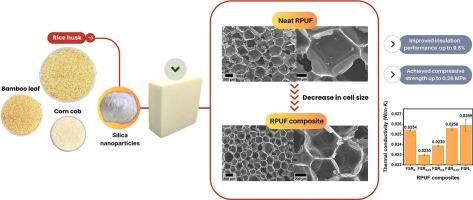农业硅增强硬质聚氨酯泡沫为高性能和可持续保温材料
IF 9.2
2区 工程技术
Q1 ENERGY & FUELS
引用次数: 0
摘要
由于全球能源消耗的增加和对节能建筑的需求,建筑施工中对可持续材料的需求正在上升。硬质聚氨酯泡沫(RPUF)是一种广泛使用的绝缘材料,但其热性能可以通过可持续改性进一步提高。本研究探讨了从农业废弃物中提取二氧化硅纳米填料,作为改善RPUF隔热和力学性能的策略。从稻壳、竹叶和玉米芯中提取二氧化硅。稻壳中提取的二氧化硅作为最有希望的补强二氧化硅源被进一步纳入RPUF配方中。热导率测试结果表明,含0.25 wt%二氧化硅(FSR0.25)的RPUF的热导率最低(0.023 W/m·K),比纯RPUF (FSR0)提高了9.45%,这是由于二氧化硅掺入的成核效应。力学试验表明,二氧化硅的增强也提高了FSR0.25的抗压强度,相对于泡沫上升,在平行和垂直方向上均达到0.26 MPa。扫描电镜和热重分析进一步证实了FSR0.25的热性能增强。这些发现表明,用二氧化硅(特别是稻壳中的二氧化硅)加固RPUF,可以最佳地提高其隔热性能和机械性能,在解决能源效率和环境问题的同时提供可持续的方法。本文章由计算机程序翻译,如有差异,请以英文原文为准。

Agricultural silica-reinforced rigid polyurethane foam for high-performance and sustainable insulation materials
The demand for sustainable materials in building construction is rising due to the increasing global energy consumption and the need for energy-efficient buildings. Rigid polyurethane foam (RPUF) is widely used as an insulating material, but its thermal performance can be further enhanced through sustainable modifications. This study explores the incorporation of silica nanofillers extracted from agricultural waste as a strategy to improve the thermal insulation and mechanical properties of RPUF. Silica was extracted from rice husk, bamboo leaf, and corn cob. Silica derived from rice husk was further incorporated into RPUF formulations as the most promising reinforcing silica source. The thermal conductivity test revealed that RPUF containing 0.25 wt% silica (FSR0.25) exhibited the lowest thermal conductivity (0.023 W/m⋅K), representing a 9.45 % improvement over neat RPUF (FSR0) attributed to the nucleation effect of silica incorporation. Mechanical testing showed that the reinforcement of silica also increased the compressive strength of FSR0.25, achieving 0.26 MPa in both parallel and perpendicular directions relative to the foam rise. Scanning electron microscopy and thermogravimetric analysis further confirmed the enhanced thermal performance of FSR0.25. These findings demonstrate that reinforcing RPUF with silica, specifically from rice husk, optimally enhances both its thermal insulation and mechanical properties, offering a sustainable approach while addressing energy efficiency and environmental concerns.
求助全文
通过发布文献求助,成功后即可免费获取论文全文。
去求助
来源期刊

Sustainable Materials and Technologies
Energy-Renewable Energy, Sustainability and the Environment
CiteScore
13.40
自引率
4.20%
发文量
158
审稿时长
45 days
期刊介绍:
Sustainable Materials and Technologies (SM&T), an international, cross-disciplinary, fully open access journal published by Elsevier, focuses on original full-length research articles and reviews. It covers applied or fundamental science of nano-, micro-, meso-, and macro-scale aspects of materials and technologies for sustainable development. SM&T gives special attention to contributions that bridge the knowledge gap between materials and system designs.
 求助内容:
求助内容: 应助结果提醒方式:
应助结果提醒方式:


